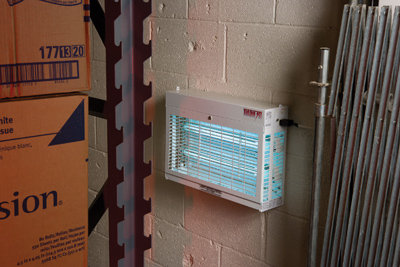
Spring forward with green goals for pest management
By Bill Melville
Features Business and Operations StaffingAs winter fades away and spring begins to emerge, dull colours and dead
plants make way for lively green foliage. While green starts to take
over outside, it’s a good time to look at how going green can work
inside as well.
As winter fades away and spring begins to emerge, dull colours and dead plants make way for lively green foliage. While green starts to take over outside, it’s a good time to look at how going green can work inside as well. The concept of being “green” has gone from a buzzword to a requirement. Have you made strides toward the environmentally responsible practices that your customers have come to expect? One easy way to introduce environmentally friendly methods into your pizzeria and help create a healthy environment for customers and staff is through green pest management.
 |
| Above: Fly lights use a fluorescent bulb to attract the pests to a sticky board. This tool is helpful in monitoring for fly populations.
|
In the world of pest control, being green translates into Integrated Pest Management (IPM). IPM programs use proactive efforts to prevent pests before they come inside, rather than waiting to treat pests once they’re established within your pizzeria. Sanitation and facility maintenance are the cornerstones of successful IPM because they minimize the need for chemical treatments. The goal of an IPM program is to use the least amount of chemicals possible while still managing pests successfully. Green pest management takes these IPM techniques a step further by helping to deal with unwanted guests while considering the environmental impact of each and every action taken.
Incorporating green pest management methods into your maintenance program can force pests to look elsewhere for their meals. They’ll have to resort to delivery rather than dining in at your restaurant.
In a sticky situation
Non-toxic sticky boards or glue boards can be used to trap pests in your restaurant. Use these boards, which may contain food lures or pheromones, in low-traffic areas such as storage closets and under equipment. Monitor for pests and consult your pest management professional if you see signs of an infestation.
Don’t look into the light
Just as our mothers warned us to avoid looking into the sun, fly lights are the thing to steer clear of for flies. The fluorescent light attracts pests to a sticky board inside a confined trap unit. Fly lights are also a great tool for pest monitoring. Once you catch pests you can identify them and track populations. Place lights near entrances to food preparation and waste disposal areas where pests naturally go in search of food. Change the sticky board regularly and light bulbs as necessary.
The air we breathe
It can’t get much greener than fresh air. Interestingly enough, you can use air to block pests or push them out of a building. Create an air curtain pests won’t be able to penetrate by positioning two fans opposite each other in a doorway. The air current ensures that even when doors open pests can’t enter along with customers. Confirm your building has positive airflow for further protection. To test your airflow, stand under a doorway with a piece of paper. If the paper blows out the air is positive, and will push pests out the door, rather than suck them in.
Go organic
Organic cleaners made with naturally occurring bacteria and enzymes help discourage pests by eliminating the grease and grime they feed on and breed in. Use a stiff brush and then an organic drain cleaner to remove the bio-film that phorid and drain flies need for reproducing. Organic cleaners can also be used on floors and equipment to remove organic matter that cockroaches, ants and flies feed on.
Repellants
Force pests to retreat with repellants, a combination of pyrethrins, compounds extracted from chrysantamum flowers and silica gel, an inorganic compound that dries out insects’ exoskeletons. Work with your pest management provider to identify small cracks and crevices in your building’s exterior and have them treated with repellant. After treatment, seal the openings with caulk to help reduce the chance of future infestations.
Take the bait
While they do contain low doses of chemical compounds, baits are formulated as gels, granules or bait pucks, so the chemical formulations do not become airborne. Non-volatile baits provide targeted and safe treatment applications that eliminate the need for residual sprays. Gels and granules are applied in cracks and crevices, and pucks can be used under equipment and in out-of-the-way places. This tool is a smarter alternative to traditional sprays as it minimizes exposure to staff and diners. Be aware that only licensed pest management professionals should apply insect baits.
False communication
Insect pheromones, which pests use to communicate, can be replicated and used against certain critters. Pheromone traps utilize synthetic versions of insect pheromones to attract pests to a sticky board. The pheromone and sticky board combination is another way to monitor for pests. Pheromone traps are also beneficial in that they do not pose a health risk to humans. The traps are most often used to collect and monitor stored-product pests like Indian meal moths.
Now that you’ve learned about a few green pest management techniques, consult with your pest management professional to determine the best and most effective methods for your establishment. Incorporating environmentally friendly practices into an established IPM program can help turn the inside of your restaurant, like the outside this spring – green! •
Bill Melville is the quality assurance director for Orkin PCO Services. He has 35 years of experience in the industry and is an acknowledged leader in the field of pest management. For more information, email bmelville@pcocanada.com or visit www.orkincanada.com.
Print this page